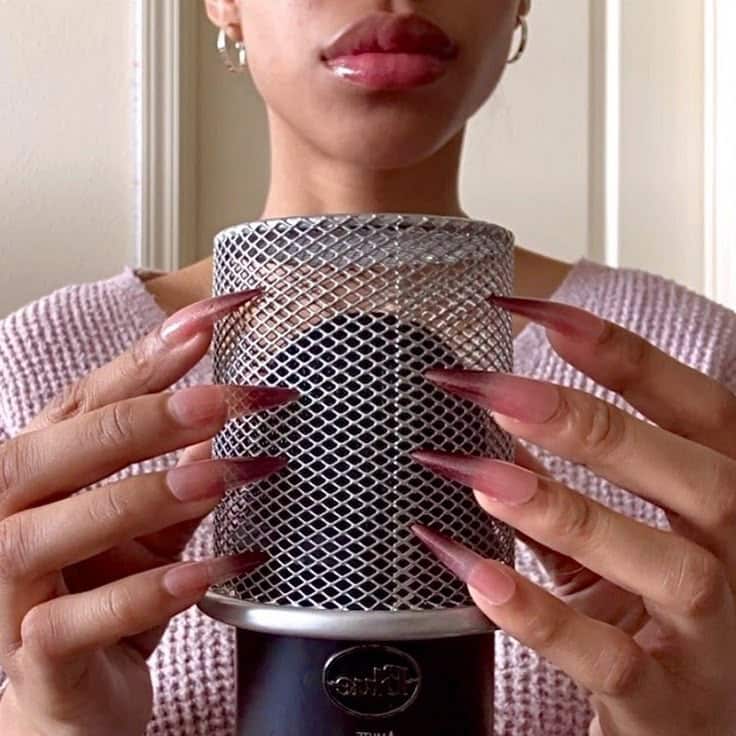You’ve probably come across videos of soft whispers, gentle tapping, or slow movements and wondered why so many people find them relaxing. ASMR, short for Autonomous Sensory Meridian Response, is a calming tingling sensation that often starts on your scalp and moves down your neck and spine. It’s not just a trend—it’s a unique sensory experience that helps many people unwind, focus, or even fall asleep.
You might notice it when someone speaks softly, when you hear delicate sounds like brushing or tapping, or when you watch careful, repetitive movements. These triggers don’t affect everyone the same way, but if you do experience them, the effect can feel both soothing and strangely satisfying. Over the past decade, ASMR has grown from a niche online community into a global phenomenon with millions regularly seeking out videos designed to spark those sensations.
What makes this even more interesting is how ASMR connects relaxation with everyday sounds and visuals you might normally overlook. Whether you’re curious about its origins, the science behind it, or the different ways people use it, exploring ASMR can give you a new perspective on how simple stimuli can influence your body and mind.



Key Takeaways
- ASMR creates a tingling, calming sensation in response to specific triggers
- It has grown from a small online trend into a widely recognized practice
- People use it for relaxation, stress relief, and better sleep
What Is ASMR?
ASMR describes a sensory response that can create a tingling feeling on your skin, often paired with relaxation. It’s linked to specific triggers, such as soft sounds or gentle movements, and not everyone experiences it in the same way.
Definition and Meaning
ASMR stands for Autonomous Sensory Meridian Response. It refers to a perceptual phenomenon where certain sounds, sights, or interactions cause a physical reaction in your body. The term “meridian” highlights the peak or climax of the sensation, while “response” reflects that it occurs only in reaction to a trigger.
You might notice ASMR described as “brain tingles” or a calming sensation that helps you relax. Many people connect it with stress relief, sleep support, or simply a pleasant sensory experience.
Common triggers include:
- Whispering or soft-spoken voices
- Tapping or scratching sounds
- Personal attention scenarios (like roleplay videos)
- Crisp noises such as paper crinkling
Not everyone responds to the same triggers, which makes ASMR a highly subjective experience.



How ASMR Feels
When you experience ASMR, you may feel a tingling sensation that usually starts on your scalp. It can then move down the back of your neck and sometimes along your spine or limbs. This feeling is not painful—it’s often described as light, soothing, and wave-like.
You might also notice a sense of deep relaxation that comes with the tingles. For some, this response is strong enough to help with falling asleep or reducing stress after a long day. Others may feel only mild comfort without the intense tingling.
Unlike other sensory reactions, ASMR is not constant. The feeling typically lasts only while you are exposed to the trigger, and it fades once the stimulus ends.
Who Experiences ASMR
Not everyone experiences ASMR, and researchers are still studying why. You may find that you respond strongly to certain triggers while a friend feels nothing at all. This difference suggests there may be individual variations in how the brain processes sensory input.
Studies show that people who do experience ASMR often report higher levels of relaxation and emotional comfort. Some even use it as part of their nightly routine to improve sleep quality.
You might also notice that your response changes over time. A trigger that once worked may lose its effect, while a new sound or visual detail can suddenly create the tingling response again. This makes ASMR a very personal and evolving experience.



History and Evolution of ASMR
You can trace ASMR from its early recognition as a curious sensation to its establishment as a global online genre. The story includes the coining of the term, the role of internet communities, and the rise of creators who shaped how you experience ASMR today.
Origins and Coining of the Term
The sensation itself has existed long before the internet, but it lacked a name. People often described it as a tingling feeling triggered by soft voices, personal attention, or gentle sounds. Without a shared term, it remained a private and somewhat mysterious experience.
In 2010, Jennifer Allen, a cybersecurity professional, introduced the phrase Autonomous Sensory Meridian Response. She wanted a neutral and scientific-sounding label that could help people discuss the phenomenon without stigma.
Allen also founded a Facebook group where early participants shared triggers and experiences. This step gave ASMR a formal identity and created a foundation for future research and community growth.
Growth of Online Communities
Once the term ASMR was established, online forums and video platforms became the main hubs for exploration. In the late 2000s, YouTube creators uploaded whispering and tapping videos, which quickly attracted viewers who recognized the sensation.
The first ASMR-dedicated YouTube channel, WhisperingLife, appeared in 2009. Its whisper videos inspired others to experiment with different triggers, from page turning to roleplays. By the mid-2010s, ASMR had grown into a recognizable internet subculture.
Websites like ASMR University, created by Craig Richard, provided educational resources and linked the community to scientific studies. This gave the movement credibility and helped you understand ASMR as more than just entertainment.
Notable ASMR Figures
Certain individuals shaped how you experience ASMR on a large scale. ASMR Darling (Taylor Darling) became one of the most popular creators, producing videos that reached millions of viewers. Her approachable style made ASMR more accessible to mainstream audiences.
Other ASMRtists experimented with diverse formats, including roleplay, mukbang, and sound-focused content. Their creativity expanded the range of triggers available to you.
Researchers like Craig Richard also became notable figures. Through ASMR University and his book Brain Tingles, he connected the community with scientific perspectives, bridging the gap between casual viewers and academic interest.



ASMR Triggers and Content Types
You can experience ASMR through a wide range of sensory triggers. These often include specific sounds, visuals, or roleplay-style interactions that create a calming or tingling response. The type of ASMR content you choose depends on which stimuli you find most effective.
Common Auditory Triggers
Sounds are the foundation of most ASMR content. Whispering, soft speaking, and gentle tapping are among the most popular auditory stimuli you’ll encounter. Many creators focus on whispering ASMR, which often produces a close and intimate effect that feels like someone speaking directly to you.
You’ll also find tapping on wood, glass, or plastic surfaces to be a frequent trigger. Scratching sounds, whether on fabric, paper, or textured objects, can create a soothing rhythm. Chewing and eating noises, sometimes called “mukbang ASMR,” appeal to those who enjoy repetitive, organic sounds.
Auditory triggers are versatile because they can be layered or combined. For example, a creator might mix whispering with tapping or scratching to produce a more immersive experience. These sounds are usually recorded with sensitive microphones to capture subtle details.
Popular Visual and Tactile Triggers
Visual triggers rely on how you respond to movement, eye contact, and hand gestures. Slow, deliberate motions such as brushing the camera lens or folding paper can create a sense of calm. Direct eye contact in videos often enhances the feeling of personal connection.
You may also notice creators using props like brushes, lights, or textured objects. Watching someone trace patterns, pour sand, or fold towels can be surprisingly effective. These triggers work because they mimic real-life tactile experiences without requiring physical touch.
Some viewers respond strongly to simulated touch, like when a creator pretends to brush your hair or clean your face. Even though you can’t feel it physically, the visual cues can create a convincing sense of relaxation.
Roleplay and Personal Attention
Roleplay is one of the most immersive forms of ASMR content. In these videos, creators act out scenarios such as spa treatments, medical checkups, or makeup sessions. The goal is to make you feel cared for in a safe and calming way.
Personal attention is a key element here. Soft-spoken guidance, direct eye contact, and gentle gestures combine to simulate one-on-one interaction. You might hear phrases of reassurance or experience a roleplay where the creator focuses entirely on your comfort.
This type of ASMR content is especially popular because it blends auditory and visual triggers. Whispering, tapping, and brushing often appear alongside roleplay, which helps deepen the overall effect.
ASMR Video Production
The way ASMR videos are produced plays a big role in how effective they feel. Creators often use binaural microphones that record sound in stereo, making whispers and tapping seem like they’re happening right next to you. This setup enhances the realism of auditory triggers.
Lighting and camera placement also matter. Many videos use close-up shots to emphasize eye contact or hand movements. A quiet background ensures that subtle sounds like scratching or brushing stand out clearly.
Some creators experiment with combining multiple triggers in one video. For example, you might watch a roleplay session while also hearing tapping or scratching in the background. This layering allows you to experience different kinds of ASMR stimuli in one piece of content.
Consistency and pacing are equally important. Slow, steady movements and sounds tend to work better than sudden changes, which can break the relaxing effect. By paying attention to these details, creators design content that feels natural and immersive.



Benefits and Uses of ASMR
You can use ASMR in different ways depending on your needs. Many people turn to it for calming the mind, improving sleep, and even feeling more connected to others through shared experiences.
Relaxation and Stress Relief
When you listen to soft whispers, tapping, or gentle hand movements, your body often responds with a sense of calm. These triggers can lower stress levels by shifting your focus away from daily worries.
Some people describe the sensation as similar to a light massage for the mind. It encourages mindfulness by helping you stay present in the moment. This makes ASMR a useful tool when you want quick relief from tension.
Studies suggest that ASMR may reduce heart rate and promote relaxation. While research is still developing, many viewers use it as a non-medical way to manage stress. You might find it especially helpful during busy or overwhelming days.
ASMR for Sleep Aid
You may notice that ASMR helps you fall asleep faster. Gentle sounds and visuals can slow down your thoughts, making it easier to transition into rest. For people who struggle with insomnia, this can be a natural alternative to medication.
Triggers like whispering, crinkling, or slow hand movements are often used by creators to promote drowsiness. The repetitive and predictable nature of these sounds can create a soothing environment for your mind.
Some users report that combining ASMR with a consistent bedtime routine makes it more effective. For example:
- Listening to ASMR before bed
- Turning off bright screens
- Practicing deep breathing alongside the sounds
This combination can help you build better sleep habits over time.
Emotional and Social Effects
ASMR can also influence how you feel emotionally. You may experience a sense of comfort or empathy when watching someone speak softly or perform caring gestures. These cues can trigger feelings similar to social bonding.
Some researchers suggest that oxytocin, a hormone linked to trust and connection, may play a role in these responses. While the science is not yet conclusive, many people describe ASMR as feeling “cared for.”
Watching ASMR can also create a sense of community. Sharing favorite triggers with others or engaging in discussions online can make you feel less isolated. This social aspect adds another layer of benefit beyond personal relaxation.



Scientific Understanding of ASMR
When you experience ASMR, your brain doesn’t just react to pleasant sounds or visuals—it engages specific regions tied to relaxation, reward, and social connection. Research using functional magnetic resonance imaging (fMRI) has started to map these responses, showing overlaps with how your brain reacts to music and other emotionally engaging stimuli.
Brain Regions Involved
Your brain activates several key regions during ASMR episodes. The medial prefrontal cortex (mPFC) often shows increased activity, which makes sense since this area is linked to emotional regulation and social bonding.
The insula also plays a role, helping you process bodily sensations and internal states. This may explain why the tingling feels both physical and emotional at the same time.
Another important region is the nucleus accumbens, which is part of the brain’s reward system. Its involvement suggests that ASMR doesn’t just relax you but can also provide subtle feelings of pleasure.
Together, these regions form part of the default mode network, a system active during rest and self-reflection. That may explain why ASMR often feels calming and introspective.
Neuroscience and fMRI Research
Studies using fMRI give you a closer look at what happens in the brain during ASMR. Researchers have observed increased connectivity between the mPFC and other sensory regions, which may explain why certain sounds or visuals trigger such a strong response.
Some studies suggest that ASMR experiences can reduce activity in areas linked to stress. This aligns with reports of lowered heart rate and feelings of calm when you watch or listen to ASMR content.
Neuroimaging also shows that ASMR can activate brain regions associated with social bonding, similar to how your brain responds to comforting interactions. This helps explain why whispering, personal attention, or gentle tapping often feel especially soothing.
Although the field is still young, these findings highlight how ASMR is more than just a sensory quirk—it’s a measurable brain response.
Comparisons with Music-Induced Chills
You might notice that ASMR tingles feel somewhat like the shivers you get from powerful music. Both experiences involve the nucleus accumbens and insula, linking them to reward and emotional processing.
However, ASMR differs from music-induced chills in important ways. Music chills are often brief and tied to sudden changes in harmony or intensity. ASMR, on the other hand, tends to be slower, sustained, and triggered by predictable sounds like tapping or whispering.
Researchers suggest that while both experiences engage overlapping networks, ASMR may rely more heavily on the default mode network and the mPFC, reflecting its connection to social cues and relaxation.
This overlap helps explain why both music and ASMR can bring you comfort, but through slightly different pathways in the brain.






